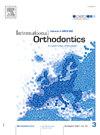Predicting treatment pathways in Class II malocclusion patients using machine learning: A comparative study of four algorithms for classifying camouflage, growth modulation, and surgical decisions
IF 1.9
Q2 DENTISTRY, ORAL SURGERY & MEDICINE
引用次数: 0
Abstract
Objectives
The aim of this study was to develop a machine-learning model to assist in treatment decision-making for surgery, camouflage, and growth modulation in Class II malocclusion patients and to evaluate its validity and reliability.
Material and methods
A total of 506 Class II malocclusion patients were included in the study, with patients randomly assigned to a training set (405) and a test set (101). Four machine-learning (ML) models – logistic regression (LR), decision tree (DT), random forest (RF), and support vector machine (SVM) – were trained to predict the most suitable treatment approach: camouflage, growth modulation (GM), or surgery. The accuracy of treatment decisions was evaluated for each model, along with 95% confidence intervals (CIs). Additionally, the McNemar's test was used to assess the statistical significance of model performance.
Results
The AUC-PR values indicate that SVM and RF are the best-performing models, both achieving 1.00 for GM, 0.92 for camouflage, and 0.82 for surgery, demonstrating strong classification capabilities across all classes. LR performs well for GM (0.97) but struggles with camouflage and surgery (both 0.66), indicating inconsistencies. The DT has the lowest overall performance, with 0.62 for GM and camouflage, and 0.55 for surgery, suggesting weaker classification reliability. Given these results, SVM and RF emerge as the most effective models, offering the best balance of precision and recall across all classes.
Conclusions
Support vector machine and random forest demonstrate strong classification for growth modulation with high precision and recall, while camouflage remains stable until 80% recall before precision declines. Surgery involves greater trade-offs between precision and recall. This study further supports that ANB, Nasolabial angle, SNA, H angle, Age, Mandibular plane angle can be used as strong predictors in assessing patient's treatment needs.
使用机器学习预测II类错颌患者的治疗途径:四种分类伪装、生长调节和手术决策算法的比较研究
本研究的目的是建立一个机器学习模型,以协助II类错颌患者的手术、伪装和生长调节的治疗决策,并评估其有效性和可靠性。材料与方法本研究共纳入506例II类错颌合患者,随机分为训练组405例,测试组101例。四种机器学习(ML)模型——逻辑回归(LR)、决策树(DT)、随机森林(RF)和支持向量机(SVM)——被训练来预测最合适的治疗方法:伪装、生长调节(GM)或手术。评估每个模型的治疗决策的准确性,以及95%置信区间(ci)。此外,采用McNemar检验来评估模型性能的统计显著性。结果AUC-PR值表明,SVM和RF是表现最好的模型,对GM、伪装和手术的分类均达到1.00、0.92和0.82,在所有类别中都表现出较强的分类能力。LR在GM上表现不错(0.97),但在伪装和手术上表现不佳(都是0.66),这表明了不一致。DT的综合性能最低,GM和伪装得分为0.62,手术得分为0.55,分类可靠性较弱。鉴于这些结果,SVM和RF成为最有效的模型,在所有类别中提供精度和召回率的最佳平衡。结论支持向量机和随机森林对生长调节具有较强的分类能力,具有较高的查全率和查全率,而迷彩在查全率达到80%之前保持稳定,查全率下降。手术需要在精确度和召回率之间做出更大的权衡。本研究进一步支持ANB、鼻唇角、SNA、H角、年龄、下颌平面角可作为评估患者治疗需求的有力预测因子。
本文章由计算机程序翻译,如有差异,请以英文原文为准。
求助全文
约1分钟内获得全文
求助全文
来源期刊

International Orthodontics
DENTISTRY, ORAL SURGERY & MEDICINE-
CiteScore
2.50
自引率
13.30%
发文量
71
审稿时长
26 days
期刊介绍:
Une revue de référence dans le domaine de orthodontie et des disciplines frontières Your reference in dentofacial orthopedics International Orthodontics adresse aux orthodontistes, aux dentistes, aux stomatologistes, aux chirurgiens maxillo-faciaux et aux plasticiens de la face, ainsi quà leurs assistant(e)s. International Orthodontics is addressed to orthodontists, dentists, stomatologists, maxillofacial surgeons and facial plastic surgeons, as well as their assistants.
 求助内容:
求助内容: 应助结果提醒方式:
应助结果提醒方式:


